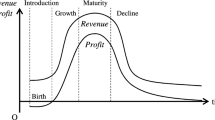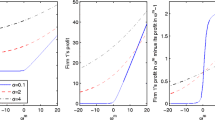Abstract
Claims of “planned obsolescence” have often been made by various consumer groups. Bulow (1986) examined a monopolist's choice of product durability and found that firms who sell their products tend to choose lower durability levels than firms that rent. We argue that the speed of new product development may be a more appropriate proxy for obsolescence than is durability. Reformulating Bulow's model in terms of R&D choice rather than durability choice, we find that sales firms engage in higher levels of R&D than do rental firms. Additionally, we provide an empirical example using data from the copier and computer industries which also suggests a strong positive relationship between the R&D intensity of a firm and the proportion of output sold versus rented.
Similar content being viewed by others
References
Bhatt, S. (1989) ‘Demand Uncertainty in a Durable Goods Monopoly’,International Journal of Industrial Organization,7, 341–355.
Bond, E. and Samuelson, L. (1987) ‘Durable Goods, Market Structure and the Incentives to Innovate’,Economica,54, 1987, 57–67.
Bucovetsky, S. and Chilton, J. (1986) ‘Concurrent Renting and Selling in a Durable-Goods Monopoly Under the Threat of Entry’,Rand Journal of Economics,17, 261–275.
Bulow, J. (1986) ‘An Economic Theory of Planned Obsolescence’,Quarterly Journal of Economics,101, 729–749.
Butz, D. (1990) ‘Durable Good Monopoly and Best-Price Provisions’,American Economic Review,80, 1062–1076.
Coase, R. (1972) ‘Durability and Monopoly’,Journal of Law And Economics,15, 143–149.
Goering, G. (1992) ‘Oligopolies and Product Durability’,International Journal of Industrial Organization,10, 55–63.
Hay, D. and Morris, D. (1991)Industrial Economics and Organization, Oxford: Oxford University Press.
Judge, G., Hill, R., Griffiths, W., Lutkepohl, H. and Lee, T. (1988)Introduction to the Theory and Practice of Econometrics, New York: Wiley.
Kamien, M. and Shwartz, N. (1982)Market Structure and Innovation, Cambridge: Cambridge University Press.
Levinthal, D. and Purohit, D. (1989) ‘Durable Goods and Product Obsolescence’,Marketing Science,8, 35–55.
Schmalensee, R. (1979) ‘Market Structure, Durability, and Quality: A Selective Survey’,Economic Inquiry,17, 177–196.
Seymour, J. (1991) ‘Intel: Is It Still Inside “The Computer Inside”’,PC Week,8, 73.
Author information
Authors and Affiliations
Rights and permissions
About this article
Cite this article
Goering, G.E., Boyce, J.R. & Collins, J.M. R&D and product obsolescence. Rev Ind Organ 8, 609–621 (1993). https://doi.org/10.1007/BF01024249
Issue Date:
DOI: https://doi.org/10.1007/BF01024249




